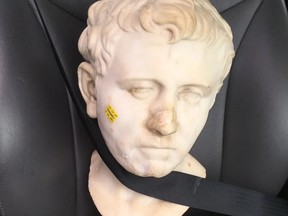Article content
Laura Young, an art collector, was browsing a Goodwill in Austin, Texas in 2018 when she came upon a find most bargain-hunters can only dream of: an authentic bust from ancient Rome, with a price tag of $34.99.
Laura Young strapped the bust to the front seat, took it home and decided to follow a hunch

Laura Young, an art collector, was browsing a Goodwill in Austin, Texas in 2018 when she came upon a find most bargain-hunters can only dream of: an authentic bust from ancient Rome, with a price tag of $34.99.
Young, who is often on the hunt for rare art pieces, bought the 52-pound marble bust and took it outside for a closer look under some natural light, she told New York Times:
“He had chips to the base. He had clear repairs. He looks old. I’ve been to museums. I’ve seen Roman portrait heads before.”
She then did what any antique enthusiast would do: she googled images of ‘Roman bust’ and realized: “They look a lot like my guy.”
Young strapped the bust, which still had a yellow price tag on its cheek, on the front seat and took it home, where she decided to follow her hunch.
For the next few years, she worked with art history experts at the University of Texas at Austin and auction houses across the U.S. to help find some answers.
She also reached out to two auction houses, Bonhams and Sotheby’s, both of which confirmed that the bust dated back to ancient Rome. Young was on vacation celebrating her 40th birthday when she received the confirmation from Bonhams. She wanted to rush home:
“He was at my house, alone.”
Jörg Deterling, a consultant for Sotheby’s, eventually gave Young a solid lead. It appeared the bust was once housed in a German museum decades ago. At some point, the bust was acquired by the Bavarian king Ludwig I, who displayed it in a full-scale replica of a home in Pompei (called the Pompejanum) in Aschaffenburg, Germany.
The Pompejanum stood for more than a century before it was heavily bombed by Allied fighters during World War II. The Bavarian government confirmed the find, but told Young she couldn’t sell it.
The bust, which was produced in ancient Rome sometime between late 1st century BC to the early 1st century AD, somehow disappeared. No one is quite sure how the bust turned up in Texas, where it laid unadmired on the floor of a Goodwill, under a table, like some ancient rebuke.
“It’s a great story whose plot includes the World War II-era, international diplomacy, art of the ancient Mediterranean, thrift shop sleuthing, historic Bavarian royalty, and the thoughtful stewardship of those who care for and preserve the arts, whether as individuals or institutions,” Emily Ballew Neff, Kelso director at the museum, stated.
The bust will be displayed at the San Antonio Museum of Art until May 2023, after which it will be returned to Germany.
[unable to retrieve full-text content]
40 Random Bits of Trivia About Artists and the Artsy Art That They Articulate Cracked.com

Source link
[unable to retrieve full-text content]
John Little, whose paintings showed the raw side of Montreal, dies at 96 CBC.ca

Source link

LONDON (AP) — With a few daubs of a paintbrush, the Brontë sisters have got their dots back.
More than eight decades after it was installed, a memorial to the three 19th-century sibling novelists in London’s Westminster Abbey was amended Thursday to restore the diaereses – the two dots over the e in their surname.
The dots — which indicate that the name is pronounced “brontay” rather than “bront” — were omitted when the stone tablet commemorating Charlotte, Emily and Anne was erected in the abbey’s Poets’ Corner in October 1939, just after the outbreak of World War II.
They were restored after Brontë historian Sharon Wright, editor of the Brontë Society Gazette, raised the issue with Dean of Westminster David Hoyle. The abbey asked its stonemason to tap in the dots and its conservator to paint them.
“There’s no paper record for anyone complaining about this or mentioning this, so I just wanted to put it right, really,” Wright said. “These three Yorkshire women deserve their place here, but they also deserve to have their name spelled correctly.”
It’s believed the writers’ Irish father Patrick changed the spelling of his surname from Brunty or Prunty when he went to university in England.
Raised on the wild Yorkshire moors, all three sisters died before they were 40, leaving enduring novels including Charlotte’s “Jane Eyre,” Emily’s “Wuthering Heights” and Anne’s “The Tenant of Wildfell Hall.”
Rebecca Yorke, director of the Brontë Society, welcomed the restoration.
“As the Brontës and their work are loved and respected all over the world, it’s entirely appropriate that their name is spelled correctly on their memorial,” she said.
The Canadian Press. All rights reserved.


Justin Trudeau’s Announcing Cuts to Immigration Could Facilitate a Trump Win


Alberta aims to add two seats to legislature, bringing total to 89 for next election


Nova Scotia election: Tory leader won’t invite Pierre Poilievre to join campaign


Pembina Pipeline earnings rise year over year to $385 million in third quarter


Restaurant Brands reports US$357M Q3 net income, down from US$364M a year ago


Canada’s Dabrowski and New Zealand’s Routliffe pick up second win at WTA Finals


Former athletes lean on each other to lead Canada’s luge, bobsled teams


Canadanewsmedia news November 5, 2024 : Canadians watch as Americans head to the polls